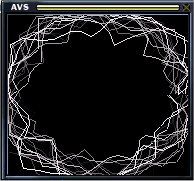Even when we used rectangular equations in the superscope (in previous tutorials), we had to not only define y with respect to x,
but x also had to be defined for i. Thus, the superscope was truly defined parametrically for both x and y with respect to i.
Enter this into the superscope:
|
Init
|
n = 50;
|
|
On Beat
|
|
|
Per Frame
|
|
|
Per Point
|
x = i*2-1-.5*v;
y = i*2-1+.5*v;
y = -y;
|
The Breakdown
- n = 50;
- This sets the number of points to define at 50. The higher n is, the more detailed the scope is.
- x = i*2-1-.5*v;
y = i*2-1+.5*v;
- Here's where the superscope is defined parametrically with respect to i. Both x and y have been multiplied by 2 and
moved by one to fit within the -1 to 1 window.
- y = -y;
- This inverts the y values so that they behave as they would if the top were 1 and the bottom were -1, instead of the
opposite (see the Window tutorial). This is essential to get the superscope to display the graph
of an equation as you expect it to be displayed.
Other Info
Along with this superscope module, don't forget to use a fadeout or blur from the +>Trans menu, or you'll end up with
little more than a blob.
Downloads
Parametric Line tutorial and demonstration AVS preset.
Parametric Circle tutorial and demonstration AVS preset.
|

x = 2*i-1+.5*v;
y = 2*i-1+.5*v;
y = -y;

x = cos(i*2*3.14159)*(1+v);
y=sin(i*2*3.14159)*(1+v);
(3.14159=pi)
|


